by Joseph Hanaway, Washington University
The original article was first published in Fontanus, Vol. 14 (2016).
Abstract: The Falcon statue, created by R. Tait McKenzie, stands as a beacon just outside the entrance of the McLennan Library Building on the main campus of McGill University. The process of acquiring this statue was not straightforward but owing to the persistence of Principal F. Cyril James, the statue of the winged youth made its way to McGill.
McGill is endowed with a fine collection of outdoor sculptures, located across the campus. One of the most prominent pieces, viewed by countless students and faculty over more than sixty years, sits on the terrace outside McLennan Library Building. The Falcon is one of the finest sculptures ever produced by R. Tait McKenzie, a McGill graduate and professor whose career was spent mostly in the United States. The story of the Falcon’s creation and how it came to McGill is a fascinating tale spread over many years, involving numerous people. [1]
John Webster (1901-1931), a leading aviation racer and the first Canadian to compete in the King’s Cup Air Race in Great Britain, July 193l, died tragically one month later in a crash at St. Hubert airfield, outside Montreal, while practicing for an aerobatic competition in the Trans Canada Air Pageant. His distraught parents, Alice and Dr. John Clarence Webster (1863-1950), of Shediac, New Brunswick, wanting a memorial for their son, decided upon an aviation trophy in his name. They commissioned Robert Tait McKenzie (1867-1938), MD, CM (1892) an old friend of young Webster’s father (from his time as a lecturer at McGill, 1896- 1899) to design the trophy.
McKenzie had an international reputation as a sculptor and was the ideal person to design a trophy memorializing young John, whom he knew well. McKenzie’s sports career began in the late 1880s in Montreal when he was on McGill’s football, boxing and gymnastics teams.[2] It was this early experience in participating and promoting physical training and athletics that led to his interest in athletic sculpture. McKenzie would later be inducted into the McGill Athletic Hall of Fame. McGill appointed McKenzie the first Director of Physical Training in 1898 and approved his plan for an athletics program, but the University lacked the necessary facilities, as it would acquire Macdonald Park only in 1911, Molson Stadium in l919 and Sir Arthur Currie Gym in 1939.
Disappointed with his situation, McKenzie began looking for other opportunities as the Director of Athletics and by publishing articles promoting the newly emerging field of physical education. The University of Pennsylvania, unlike McGill, had a gymnasium, pool, quarter-mile track and a large football stadium – Franklin Field – offered him the opportunity of becoming Professor and Director of Physical Education in 1904.[3] In accepting the offer, he also accepted a studio where he could pursue his interest in athletic sculpture.
McKenzie’s early sports sculpture, undertaken in Montreal to demonstrate surface anatomy, focused on boxer and track and field athletes: runners, discus throwers, and pole-vaulters.[4] A statue of Benjamin Franklin called “The Youthful Franklin”, unveiled in 1914 at the University of Pennsylvania was his first major work in Philadelphia. World War I (1914-1918) stimulated his interest in military sculpture, which accounts largely for his enduring artistic reputation. His Great War memorials and statues can be found at Balmoral Castle (1919), in Cambridge, England (1922), the House of Commons, Ottawa (1923), and the Princess Street Gardens, Edinburgh (1927). In addition, there is a large statue of General Wolfe in Greenwich, England (1928).
In response to the Websters’ request, McKenzie proposed a trophy depicting a youthful male with large wings, standing on a globe ready to fly. Completed in 1931 and called the “Triumph of Flight”, the Webster Memorial Trophy is a “bronze figure of the mythical Greek god, Icarus, and symbolically represents youth and flight”; the speed, daring, and courage of the modern aviator. Since 1932 the trophy has been presented symbolically at an annual ceremony to the top amateur Canadian aviator. No presentations were made between 1940 and 1946 due to World War II, nor between 1955 and 1979, due to financial concerns. Since 1980, the award ceremony has been supported by sponsors. The trophy resides in the Canadian Aviation and Space Museum. [5]
McKenzie liked the trophy so much that he experimented with a full- scale version, deciding finally upon a 1.2m high version with a 1.7m wing span. To perfect the wings and feathers he spent hours in a local zoo observing, taking notes, and drawing the wings of raptors. The statue, called “The Falcon,” was completed in 1931 and assumed great meaning for him according to this 1935 description:
I have modeled the figure to express the perfect beauty of the youthful form and have tried to follow, in so doing, the great tradition of sculpture. The buoyant figure is framed by its four wings. They form an areola about it and give volume and background to the slenderness of the figure. The aviator is moving forward from a position of rest on his left foot, the right ready to act when he takes off for flight. The left wing is already extended; the right wing is just about to be raised. Of the two rear wings to complete is biplane, the left is still partly folded while the right one is partly extended to balance the mass of the fully spread front wing on the other side. He is gazing keenly upward and forward. On his head the flying helmet is conventionalized into a hawk’s mask with its keen eye and short, curved and notched beak. [6]
This would be McKenzie’s last major work before his death in 1938. Although he had expressed his desire that it go McGill as a token of gratitude to his alma mater, it remained a plaster cast in his Philadelphia studio until the early 1950s – his widow’s attempts to sell it for $5,000 proving unsuccessful.
Frank Cyril James (1903 – 1973), a brilliant young British Professor at the Wharton School of Commerce, University of Pennsylvania (U of P), and an old friend of McKenzie, arrived at Wharton in 1923. Then 20 years old, he had arrived from the London School of Economics on a traveling scholarship. He soon earned his MA and Ph.D., and by 1935 was a full Professor of Finance and Economic History. His enviable publication record established him quickly as a leading authority of American finance and banking. He was polished and bright, and despite being British had earned a strong American reputation. By 1935 he was considered one of the leading professors at U of P. [7]
Six hundred miles north in Montreal, Lewis William Douglas (1894 – 1974), McGill University’s tenth Principal (1937 – 1939) wanted to revive the Commerce Department, and James was his choice for chairman. They met four times before the reluctant James, who didn’t want to sever his connection with Wharton, agreed to come to McGill for a two year period. In addition to chairing the department and having the Principals’ full support, James received a significant increase in income. His arrival in Montreal on September 3, 1939, coincided with the outbreak of World War II. [8]
Douglas, an American (albeit with Canadian roots) considered it inappropriate to remain in Canada which had entered the war immediately in support of Britain. In addition, he wanted to take a position in the American government. He informed the Board of Governors that he planned leaving McGill by December 1939, or as soon as another Principal could be found.
Unbeknownst to James, he was soon considered a candidate for the post, and to his surprise, was invited to dinner by leading members of Montreal’s Anglophone community. As their evaluations and reports were favorable -James impressed everyone with his intelligence and style – Principal Douglas and the Chancellor, Sir Edward Beatty (1877 – 1943), were satisfied that they had the right man for the job. On October 26th he was offered the principalship, which he accepted four days later on October 30th, 1939. A relieved Douglas said his farewells, and left Montreal November 1st. James served as interim Principal until January 12, 1940, when he was officially installed as McGill University’s 11th Principal and Vice Chancellor – retiring in 1962. [9]
As an expatriate in Philadelphia curious about life in the United States and at the U of P, James sought out other expatriates including Canadian Tait McKenzie, with whom he became friends. James knew about the Falcon, and McKenzie knew about James going to McGill. After Tait’s death in 1938, his widow Ethel continued the friendship with James. In 1945, during the course of a thank-you letter (7/8/45)[10], she mentioned that the Falcon remained unsold, that s he wanted $5000 for it, and that the estimated cost of casting it in bronze and shipping it would be an additional $4500. James answered (7/25/45)[11] that he wanted the statue to come to McGill to fulfill her husband’s wish, as soon as he could find a benefactor willing to provide the money. A second letter (10/23/45) reiterated how much he wanted the Falcon in Montreal, and asked her not to sell it to anyone else.
Six years later, Gordon Lewis, a Montreal insurance broker in the firm Lewis, Apedale and Hanson Ltd., over lunch with Principal James in May of 1951, said that he wanted to donate $10,000 anonymously to McGill for a special project in memory of his wife Eva. A delighted James responded in a letter (5/23/51)[12] outlining his idea of acquiring a wonderful statue by a graduate that would cost $10,000, and that Lewis’s support of the project could be kept anonymous. Two days later, James informed Ethel McKenzie (5/25/51)[13] that he had an eager donor who was willing to acquire the Falcon for McGill, and pay the full amount for bronzing and transporting it.
Anxious to have the project completed, James contacted the Philadelphia Museum of Art for advice on bronzing and was given the name of a reliable firm: the Roman Bronze Works, of Greenport, N. Y. After inspecting the plaster statue in Philadelphia, the company estimated that the cost for the entire process including transportation of it to Greenport and the finished statue to Montreal would be $4,500.00. The company’s first attempt to transport the plaster cast to Greenport was thwarted by Ethel McKenzie being in hospital. The second attempt, on August 31st, 1951 proved successful.
James’s desire was to have the statue on campus in time for the October 1951 visit of Princess Elizabeth and Prince Philip during their royal tour of Canada[14] (a few months before the death of King George VI, and the Princess becoming Queen Elizabeth II). This proved impossible due to the post-war shortage of bronze in the US. The Roman Company apologized, but said (9/21/51)[15] that the job would take three months or longer. In fact, the statue would be shipped to Montreal by Railway Express in early 1952 (1/29/52). [16]
Disappointed by the delay, James began planning a site for the statue. His first thought was to place it inside the Roddick Gates, where a sidewalk now leads off to the right towards the current Otto Maass Chemistry building. A photo in the James Collection of the McGill University Archives shows the statue temporarily on this site, in 1952 but with a different base from the present one.
A local architect, J. M. MacDougall, who was designing the statue’s marble base, suggested (7/13/51)[17] that a better and more secure place would be on the terrace, facing the campus, which was being constructed as part of the major expansion of Redpath Library. In the end, MacDougall’s suggestion, along with his design for a marble base, was adopted.
After the arrangements had been completed for relocating the Falcon on the newly constructed Redpath Library Terrace, doubts were raised about the authenticity of the statue, based apparently upon misinterpreted photographs of three versions of McKenzie’s smaller trophy statue “Triumph of Flight.” In addition to the Aviation and Space Museum in Ottawa, variations are held by the R. Tait McKenzie Memorial Museum at the Mill of Kintail Conservation Area, Almonte, Ontario, and at the Lloyd P. Jones Gallery of the University of Pennsylvania.
McGill’s Comptroller, Sidney Dobell, who enjoyed only a peripheral involvement with the project, (7/8/53) wrote to the Associate Director of the Philadelphia Museum of Art questioning whether McGill received the right one[18]. Richard Pennington, McGill’s University Librarian sent a memo to Dobell 7/29/53[19] also questioning its authenticity. The Principal’s response (8/11/53)[20] put these questions to rest stating that he had seen the Falcon being cast, and that McGill had McKenzie’s final and only surviving version.
On Founder’s Day, October 6th 1953, in the presence of Principal James and other dignitaries, the extension to Redpath Library was inaugurated along with the unveiling of the Falcon on the Library’s new terrace entrance overlooking the campus. Although Gordon Lewis – who had withdrawn his insistence upon anonymity – was not present, James wrote him expressing thanks and appreciation.
In 1969 with the opening of McLennan Library immediately to the south, the Falcon was moved several hundred feet outside the entrance to the new library. A major renovation of the terrace in 2012-13 resulted in the Falcon’s position on the terrace being changed again, to better display its dramatic appearance.
The inscription on the black marble base remains the same:
THE FALCON
BY R. TAIT McKENZIE
GRADUATE OF McGILL UNIVERSITY
AND A MEMBER OF
ITS TEACHING STAFF
FROM 1894 TO 1904
PRESENTED TO THE UNIVERSITY
BY GORDON LEWIS
IN MEMORY OF EVA MAUD LEWIS
This study could not have been done without the help of Anne Usher RN and Gordon Burr of the McGill University Archives.
[1] A. Kozar, The Sports Sculpture of R. Tait McKenzie, Human Kinetics Books (Champaign,IL: 2nd Ed., (1992), 13; Letter from the curator of the Mill of Kintail, Douglas Keddie, to MacDonald Professor of Architecture, John Bland, of McGill University; 1/27/7, MUA, F. Cyril James fonds, RG2 c.156 file 05474, Gifts: C.G. Lewis, Library New Building; Falcon Statue, 1951-1954; M. Nicholls, “Alders Captures 2011 Webster Trophy”, Wings Mag. July/August, 2011.
[2] J. McGill, The Joy of Effort. A Biography of R. Tait McKenzie (Sewdley, Ontario: Clay 5 Publishing Co, 1980, 13; F. Cosentino, Almonte’s Brothers of the Wind (General Store Publishing House, Burnstown, Ont, 1996), 23-50.
[3] McGill, 44; Cosentino, 40
[4] Kozar, VII-XV
[5] Press Release: Manitoba Student declared “Top Amateur Pilot in Canada”, Flying Colors Pilot Training, 1/9/2001.
[6] The Falcon by R. Tait McKenzie. (His own description of the statue written December, l935) MUA, F. Cyril James fonds, Office of the Principal, Gifts: C.G. Lewis, Library New Building; Falcon Statue, 1951-1954, RG2 c156 file 05474.
[7] Stanley Frost, The Man in the Ivory Tower. F. Cyril James of McGill (McGill/Queens University Press, Montreal, 1991), 22-25.
[8] Frost, 54-60; F.C. James in Andrew Collard’s The McGill You Knew, An Anthology of Memories 1920-1960 (Longman, Canada Ltd., Don Mills, Ont., 1975) Ch. 33:250-54.
[9] Frost, 62 Items 10-13 and 15-19 are in the Falcon Statue file in the MUA, MUA, F. Cyril James fonds, RG2 c156 file 05474.
[10] McGill University Archives (MUA), F. Cyril James fonds, Office of the Principal, Letter from Ethel McKenzie (EM) to F.C. James (FCJ) 7/8/45, Gifts: C.G. Lewis, Library New Building; Falcon Statue, 1951-1954, RG2 c156 file 05474.
[11] MUA, James fonds, file 05474, Letters from FCJ to EM 7/25/45 & 10/23/45
[12] Ibid. Letter from FCJ to G .Gordon Lewis (GGL) 5/23/51
[13] Ibid. Letter from FCJ to EM 5/25/51
[14] Ibid. McGill Daily vol. XLI #21 10/29/51
[15] Ibid. Letter from Roman Bronze Worksto FCJ 9/21/51
[16] Ibid. Letter from Roman Bronze Works , regarding shipping date 1/29/52
[17] Ibid. Letter from J.M MacDougal to FCJ 7/13/51
[18] Ibid. Letter from Sidney Dobell to Assoc. Director of the Philadelphia Museum of Art 7/8/53
[19] Ibid. Memo from R. Pennington to S. Dobell 7/29/53
[20] Ibid. Letter from FCJ to R. Pennington 8/11/53



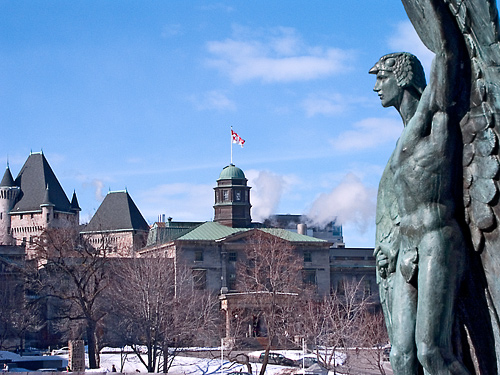
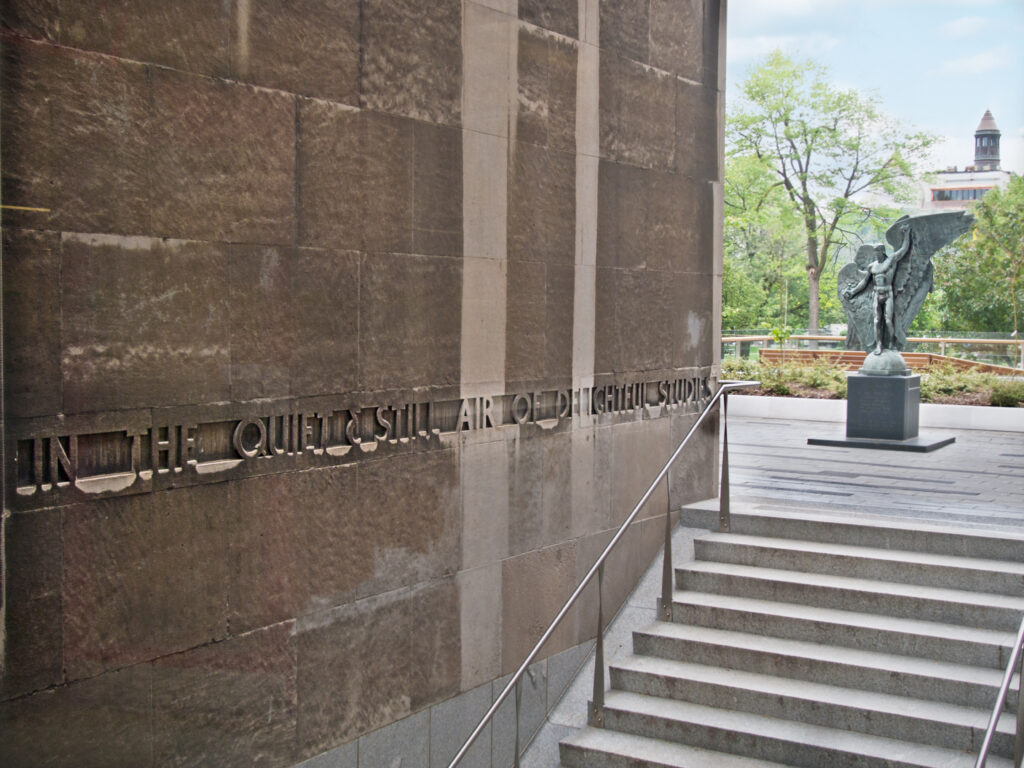
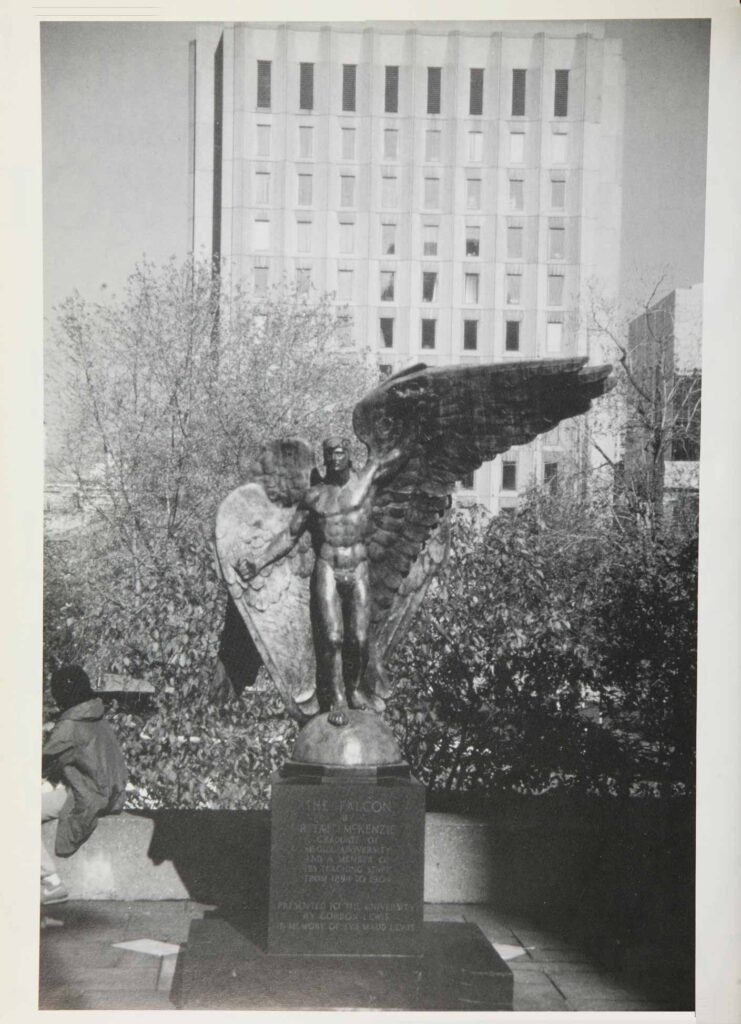
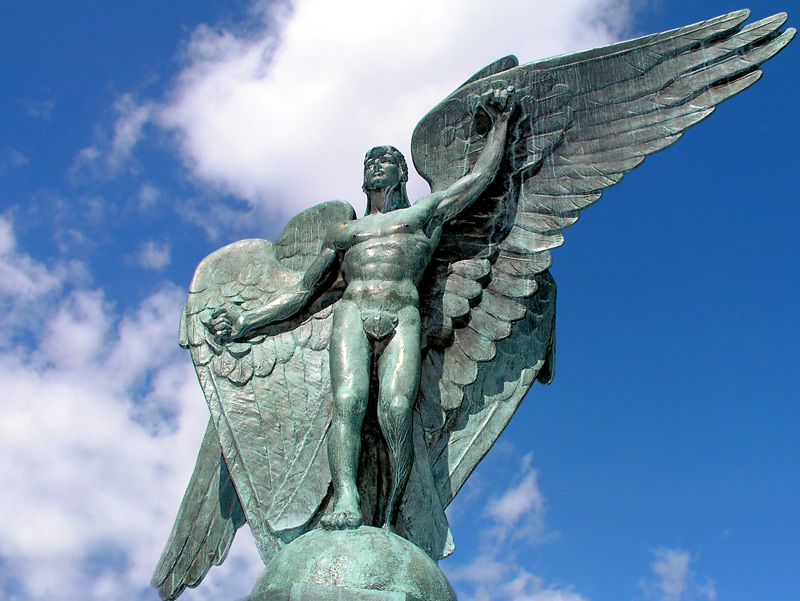
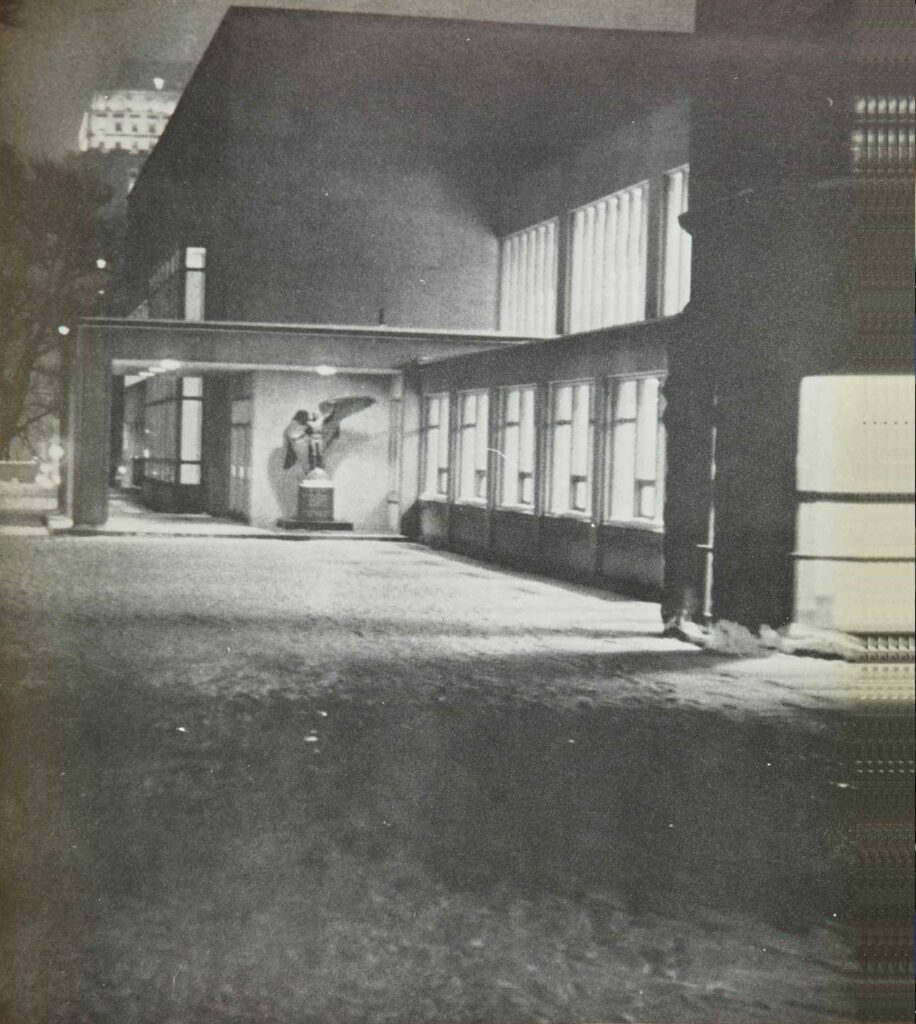

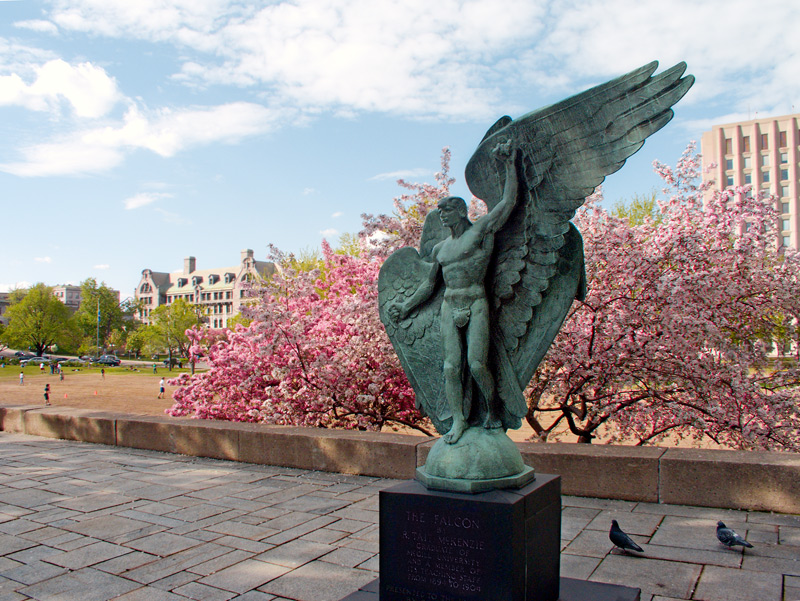
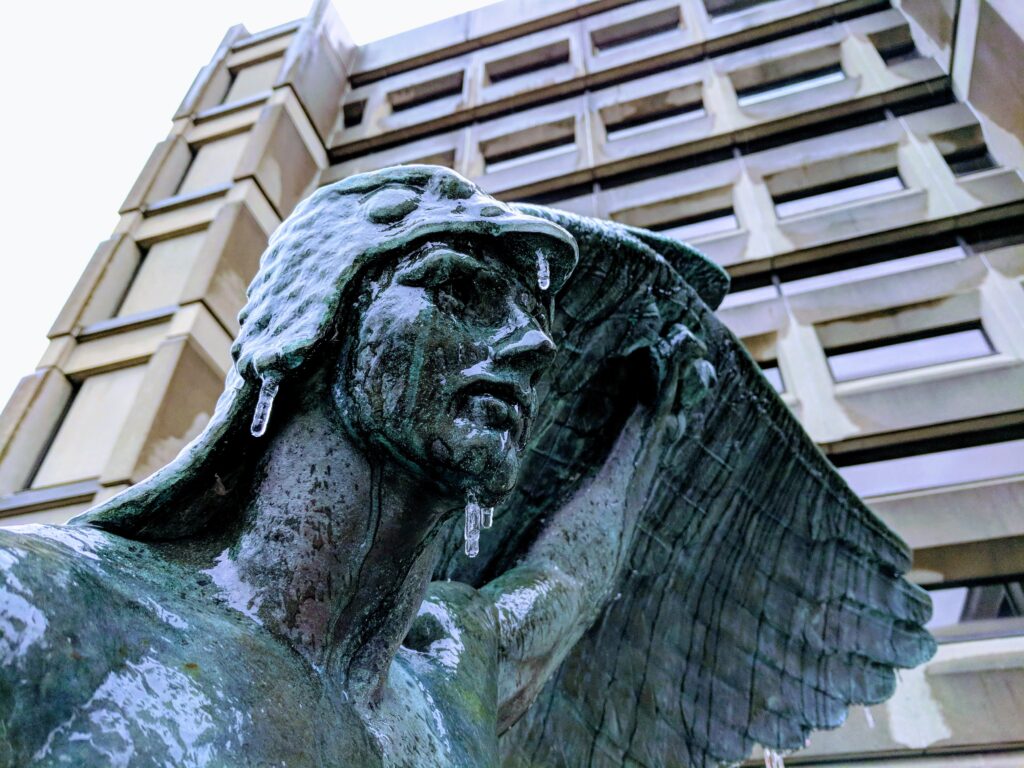










Leave a Reply
You must be logged in to post a comment.